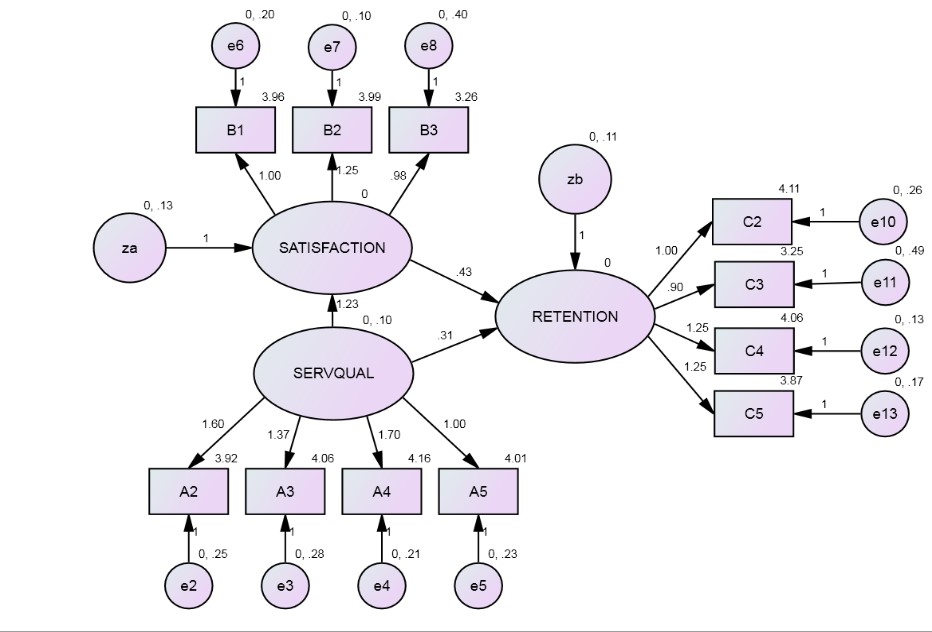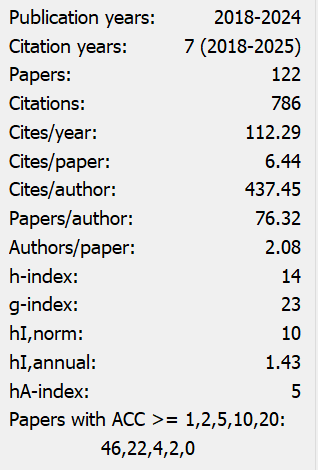Analysis of Educational Quality Based on Quality, ServQual and Retention of Students
Abstract
This study analyzed the influence of ServQual (service quality) on satisfaction and student retention. The sample used was 175 STIESIA Surabaya students using non probability sampling called, accidental sampling. Data analysis used Structural Equation Modeling (SEM) with AMOS 21 software. Based on the discussion of the hypotheses proposed in this study, the conclusions are as follows: 1). There is a positive influence between ServQual on satisfaction. This is based on the results of the parameter coefficient output. It is known that the relationship of the ServQual construct to satisfaction is significant at 0.001 (sign p = ***) with a standardized parameter coefficient of 0.735. Thus, if ServQual is good, students will be satisfied, and vice versa if ServQual is bad, students will not be satisfied. 2) There is a positive effect of satisfaction on student retention. This is based on the results of the output coefficient parameter construct relationship satisfaction to student retention significant at 0.001 (p = 0.001) and standardized parameter coefficient of 0.513. Thus if student satisfaction is high then student retention is also high, and vice versa if satisfaction is low then student retention is also low. 3) There is no influence between ServQual on student retention indicated by the output parameter coefficient at 0.001 (p = 0.132) This proves that loyalty cannot be created through service quality, but through satisfaction first. thus, it can be said that satisfaction has a mediating effect between ServQual and Student Retention.
References
Cronin, Jr. J. J., & Taylor, S. A. (1994). SERVPERF versus SERVQUAL; Reconciliation performance based and perceptions minus expectations. Journal of Marketing, 58(1), 125. https://doi.org/10.1177/002224299405800110
Darsono, L. I., & Junaed, C. M. (2006). An Examination of Perceived Quality, Satisfaction, and Loyalty Relationship Applicability of Comparative and Noncomparative Evaluation. Gadjah Mada International Journal of Business, 8(3), 323-342. https://doi.org/10.22146/gamaijb.5612
Emari, H., Iranzadeh, S., & Bakhshayesh, S. (2010). Determining the dimensions of service quality in banking industry: Examining the Grönroos’s model in Iran. Journal of Compilation, 1-5. https://doi.org/10.3923/tasr.2011.57.64
Faullant, R., Matzler, K., & Füller, J. (2008). The impact of satisfaction and image on loyalty: the case of Alpine ski resorts. Managing Service Quality, 18(2), 163-178. https://doi.org/10.1108/09604520810859210
Ghozali, I. (2011). “Aplikasi Analisis Multivariate Dengan Program SPSS”. Badan Penerbit Universitas Diponegoro. Semarang.
Kotler, P., & dan Keller, K. L. (2009). Manajemen Pemasaran. Edisi 13, Jilid 1, Erlangga. Jakarta.
Kunanusorn, A., & Puttawong, D. (2015). The Mediating Effect Of Satisfaction On Student Loyalty To Higher Education Institution. European Scientific Journal, 1, 449-463.
Mahmud, M. (2012). Manajemen Mutu Perguruan Tinggi. PT Raja Grafindo Persada, Jakarta.
Onditi, E. O., & Wechuli, T. W. (2017). Service Quality and Student Satisfaction in Higher Education Institutions: A Review of Literature. International Journal of Scientific and Research Publications, 7(7), 328-335.
Quoquab, F., Abdullah, N. L., & Mohammad, J. (2016). Investigating the Effects of Consumer Innovativeness, Service Quality and Service Switching Costs on Service Loyalty in the Mobile Phone Service Context. Gadjah Mada International Journal of Business, 18(1), 21-53. https://doi.org/10.22146/gamaijb.9286
Roberts, J., & Styron, D. R. (2009). Student Satisfaction And Persistence: Factors Vital To Student Retention. Research in Higher Education Journal, 1-18.
Sembiring, M. G. (2014). Modeling The Determinants Of Student Retention In Distance Education Institutions. International Journal of Continuing Education and Lifelong Learning, 6(2), 15-28.
Shahin, A., & Dabestani, R. (2010). Correlation analysis of service quality gaps in a four-star hotel in Iran. International Business Research, 3(3), 40-46. https://doi.org/10.5539/ibr.v3n3p40
Tjiptono, F., & dan Chandra, G. (2016). Service, Quality dan Satisfaction. Edisi 4. Andi Offset. Yogyakarta.


This work is licensed under a Creative Commons Attribution 4.0 International License.
Copyright for this article is retained by the author(s), with first publication rights granted to the journal.
This is an open-access article distributed under the terms and conditions of the Creative Commons Attribution license (http://creativecommons.org/licenses/by/4.0/).


























